
   |
 |
|
|
|
History of
Sundials
For centuries, sundials have been used to mark the passage of time while reminding us of the rhythms of our universe. While modern day timepieces have long-since replaced the practical usefulness of the ancient sundial, there remains a sense of nostalgia and mystery that makes sundials highly appropriate as functional garden accents. It is not known exactly when the sundial was invented, or what people invented it. Sundials can be found in many ancient civilizations, including the Babylonian, Greek, Egyptian, and Roman ages. Sundials exist in most countries, in various forms, differing in construction according to the knowledge of the age in astronomy and mathematics, and showing clearly at different periods in the history of a race evidence of influence by other civilizations with greater knowledge. Sundials are also abundant in the far East such as China and Japan, but not as much history of these is known to the Western world. The oldest known dials at present are those of Grecian origin, and for the most part are of the Hemicyclean form invented by the Chaldean Berosus, who lived about 340 B.C. Four of these sundials were discovered in Italy: one at Tivoli in 1746, another at Castel Nuovo in 1751, another at Rignano in 1751, and the fourth at Pompeii in 1762. It is also evident that this form of sundial was used by the Arabians and was also popular among the Romans. Herodutus, writing in 443 B.C., says that the Greeks acquired their knowledge of the sundial from the Babylonians. Roman writers in turn give evidence of their acquisition of this instrument from the Greeks. The Romans eventually constructed many beautiful sundials of various original designs. The first of these sundials was erected in Rome in the year 290 B.C., adopted from the Samnites by Papirius Cursor. Another was brought to Rome by Valerius Messala from Catania in 261 B.C., but it was not until 164 B.C. that a sundial constructed at Rome was set up by order of Q. Marcius Phillipus. The Saxons used a simple sundial long in use by the Vikings, who, being a maritime race, founded the divisions of time on the ebb and flow of the tide. First, the four tides, two high tides, and two low; then, further improving this, they subdivided these divisions again into halves and quarters, thus making the day and night equal to sixteen hours. Today we introduce the sundial into our gardens more for its ornamental value than from any wish to use it as a timekeeper, though it is still as reliable as the sun in this regard. The use of recycled materials in the construction of these sundials is an apt reflection on their gentle harmony with nature. Moreover, it is the love of the aesthetic that causes this age-old instrument to live on well beyond the edge of its technological usefulness. The increased interest that has been taken in the sundial during recent years shows it has still a great future before it. If age can only add to its value, and yet in nowise impair its reliability, who will be without such a garden ornament that offers such a gentle touch to what is already a beautiful possession? |
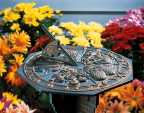 Butterfly Sundial
Butterfly Sundial
Bronze 10" Diameter. |
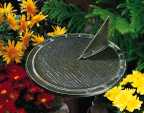 Day Sailor Sundial
Day Sailor Sundial
Bronze 9.5" Diameter. |
 Dragonfly Sundial
Dragonfly Sundial
"Flying jewel how quick your flight reflect the passage of day to night." Bronze 12" Diameter. |
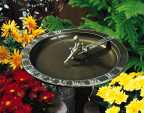 Fisherboy Sundial Birdbath
Fisherboy Sundial Birdbath
12.5" diameter. Available in Weathered Bronze or Verdigris. |
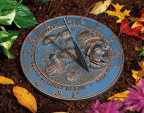 Frog Sundial
Frog Sundial
"A quick summer's glimpse, reveal egg, tadpole and frog, life in constant change." Bronze 12" Diameter. |
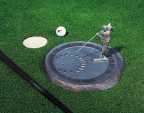 Golfer Sundial
Golfer Sundial
Bronze 12" Diameter. |
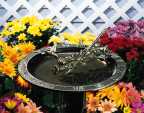 Hummingbird Sundial Birdbath
Hummingbird Sundial Birdbath
12" diameter. Available in Weathered Bronze or Verdigris. |
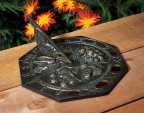 Large Butterfly Sundial
Large Butterfly Sundial
Contains names of butterfly-attracting floral species. Bronze 12.5" Diameter. |
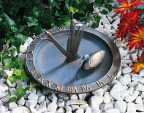 Loon Sundial Birdbath
Loon Sundial Birdbath
12" diameter. Available in Weathered Bronze or Verdigris. |
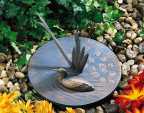 Loon Sundial
Loon Sundial
Bronze 11.25" Diameter. |
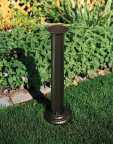 Roman Sundial Pedestal
Roman Sundial Pedestal
26" High x 8" Diameter Base. |
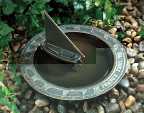 Sailboat Sundial Birdbath
Sailboat Sundial Birdbath
12.5" diameter. Available in Weathered Bronze or Verdigris. |
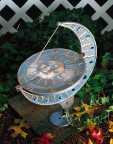 Sun & Moon Sundial
Sun & Moon Sundial
15.5" High x 8.75" Diameter. Available in Weathered Bronze or Verdigris. |
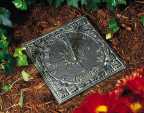 Sunny Hours Sundial
Sunny Hours Sundial
"I count none but sunny hours." Bronze 8.25" Long x 8.25" Wide. |
|
Ads by Google |

Home
Page |
Product Review Page | Help
 Woodside Gardens
The Registry of Nature Habitats
Woodside Gardens
The Registry of Nature Habitats 
 1999 -
1999 -
All Rights Reserved
Last Updated: